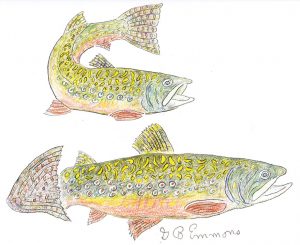The colorful brook trout is an indigenous cold water fish in New England streams such as our local Mattapoisett and Sippican Rivers, true to the heritage of their Native American names. As a biological member of the northern char family, the brook trout spawns in autumn rather than in spring like many other aquatic species.
As it becomes even more colorful to match the autumn foliage as the shorter days and colder nights cut off the supply of chlorophyll to trees of deciduous leaves of the maples, oaks, aspen, and sumac, Mother Nature similarly and simultaneously paints the bellies of the trout a flaming red as they swell with roe and morph their backs with green and blue worm-like markings of contrasting ceremonial regalia, as in my illustration, to dance to the Indian Summer celestial drum beat of reproduction.
Sportsmen have affectionately call it “Brookie” as one of their favorite angling rewards with a voracious appetite and fighting fury when hooked after dashing out from the back eddy of a streamside boulder to bite at almost any reasonably presented dry or wet fly, or even by a youngster dangling a terrestrial squirming worm for the thrill of landing such a beautiful prize.
Such a magnificent aquatic performance has inspired conservation-minded sportsmen, especially fly fishermen, to gradually customize the practice of “catch and release,” deserving of at least one curtain call at a later time and bigger size, or even for someone else. This concept of release is gaining in popularity almost everywhere in the sporting world.
The species goes back in historical time and place to the cold water habitat of pristine pools of runoff of the melting of the Wisconsin glacier some 25,000 years ago. Their adaptation to such cold water gave them constitutional survival capacity all over Northern New England, except in the late 19th century when fir trees that shaded streams we cut down by tanneries for turpentine to cure hides. Unfortunately, these were buffalo hides that came in an unending stream of railroad freight cars from the western plains, almost wiping out buffalo from the face of the Earth. Simultaneously, the lack of shade on trout waters increased the temperature, diminishing the brook trout population in most New England States.
Now the brook trout has recovered from near extinction and, as we speak, move upstream by falling water temperatures to select a pristine bed of loose gravel and a good supply of oxygen.
In reproduction once again, they are ceremoniously completing an unbroken circle of their kind, traditional to the original period of natural post-glacial global warming which hopefully will be followed by another cycle of eventual cooling in keeping with the unending orbit of planets in the sky. Then Mother Earth may herself recover from all that we have done to her, but as in my tale of the brook trout, not without our help.
By George B. Emmons
